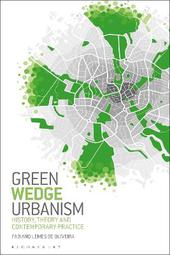
|
Green Wedge Urbanism: History, Theory and Contemporary Practice
Paperback / softback
Main Details
| Title |
Green Wedge Urbanism: History, Theory and Contemporary Practice
|
| Authors and Contributors |
By (author) Professor Fabiano Lemes de Oliveira
|
| Physical Properties |
| Format:Paperback / softback | | Pages:304 | | Dimensions(mm): Height 234,Width 156 |
|
| Category/Genre | Landscape art and architecture
History of architecture |
|---|
| ISBN/Barcode |
9781350154346
|
| Classifications | Dewey:711.4 |
|---|
| Audience | | Tertiary Education (US: College) | |
|---|
| Illustrations |
87 bw illus
|
|
Publishing Details |
| Publisher |
Bloomsbury Publishing PLC
|
| Imprint |
Bloomsbury Visual Arts
|
| NZ Release Date |
6 February 2020 |
| Publication Country |
United Kingdom
|
Description
As towns and cities worldwide deal with fast-increasing land pressures, while also trying to promote more sustainable, connected communities, the creation of green spaces within urban areas is receiving greater attention than ever before. At the same time, the value of the 'green belt' as the most prominent model of green space planning is being widely questioned, and an array of alternative models are being proposed. This book explores one of those alternative models - the 'green wedge', showing how this offers a successful model for integrating urban development and nature in existing and new towns and cities around the world. Green wedges, considered here as ducts of green space running from the countryside into the centre of a city or town, are not only making a comeback in urban planning, but they have a deeper history in the twentieth century than many expect - a history that provides valuable insight and lessons in the employment of networked green spaces in city design and regional planning today. Part history, and part contemporary argument, this book first examines the emergence and global diffusion of the green wedge in town planning in the late 19th and early 20th centuries, placing it in the broader historic context of debates and ideas for urban planning with nature, before going on to explore its use in contemporary urban practice. Examining their relation to green infrastructures, landscape ecology and landscape urbanism and their potential for sustainable cities, it highlights the continued relevance of a historic idea in an era of rapid climate change.
Author Biography
Fabiano Lemes de Oliveira is Associate Professor in Urbanism at Politecnico di Milano. His research interests include urban design theory, modern architecture history and exploring the relationship between modern planning ideas and landscape architecture.
ReviewsGreen Wedge Urbanism provides an original and potentially impactful contribution to urban theory, history and practice. The narrative of the book surfaces the concept of the Green Wedge historically and geographically, acting both as an archaeology of its meaning and a critical examination of its contemporary practice. * Simon Guy, Dean of the Faculty of Arts and Social Sciences, Lancaster University, UK * This fascinating and historically informed account sheds new light on the urban landscape, reminding us of the benefits of linear open space, whether as an alternative to encompassing green belts or (even better) in combination with them. * Michael Hebbert, Professor of Town Planning at University College London, UK * A strong argument for the significance of the concept in planning history and practice. Overall, Lemes de Oliveira's chronicle of the green wedge concept adds significantly to our understanding of this impactful model. It will be useful for environmental and regional planners, particularly those with an interest in planning history or theory. . . . Appropriate for graduate-level courses. * Journal of Planning Education and Research * The book provides new, scientifically sound information on the design of green corridors in numerous cities, past and present. . . . The book is very well suited as a textbook as well as a comprehensive study for anyone interested in urban and green space planning. * Journal of the Finnish Society of Urban Planning *
|